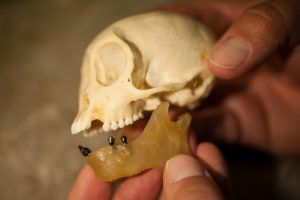By Ana Verayo, | April 21, 2016

Placed in a wax jaw, fossil teeth belonging to Panamacebus transitus are compared with those of a modern female tufted capuchin, Cebus apella.
Some 21 million years ago, monkeys apparently migrated and completed crossing of at least 100 miles into the open ocean from South America to the North American continent, even before the two continents became connected to each other.
Scientists reveal this amazing feat upon the discovery of evidence based on seven tiny primate teeth that were uncovered from excavations during the Panama Canal expansion, which proves how monkeys reached North America much earlier than first thought.
Like Us on Facebook
The tiny teeth belonged to a species known as Panamacebus transitus which is described as a medium sized monkey. Since South America was isolated from other continents, there was a wide array of exotic mammals that evolved, that can be described as a "splendid isolation" according to American paleontologist George Gaylord Simpson.
Bloch and the team also reveals that the largest among the molars are measured five millimeters, which is a telltale clue of a South American monkey, where its shape also showed that the Panamacebus thrived on fruit in its tropical forest habitat.
However, it is also quite mysterious how the Panamacebus swam across the deep and vast oceans, as monkeys are not known to be good swimmers.
According to Jonathan Bloch of the Florida Museum of Natural History at the University of Florida, at the time, Panama was part of the southernmost region of North America. The specimen may have swam across which covers a distance of more than 100 miles, which sounds almost impossible to complete. This means that it could have unintentionally drifted on a raft made from vegetation.
Bloch says that these monkeys were the only known mammals that successfully crossed the ocean from South America to present day Panama. Apart from them, the South American giant ground sloth managed to reach the northern American continent some nine million years ago even if it was not until 3.5 million years ago that the Isthmus of Panama fully formed. This land bridge allowed animals to trek in larger numbers between the two continents, producing the most massive interbreeding of species on record.
Bloch also says that the discovery of monkeys that used to dwell in North America was "mind bending" as it was traditionally known that they did not thrive in the region during that time.
Monkeys are known to originate from Africa and then later spread out to the different regions of the planet. Scientists also consider that monkeys could have completed an even longer transatlantic voyage some 37 million years back, when they first ventured out of the African continent to South America via the same floating debris.
This new study is published in the journal Nature.
-
Use of Coronavirus Pandemic Drones Raises Privacy Concerns: Drones Spread Fear, Local Officials Say

-
Coronavirus Hampers The Delivery Of Lockheed Martin F-35 Stealth Fighters For 2020

-
Instagram Speeds Up Plans to Add Account Memorialization Feature Due to COVID-19 Deaths

-
NASA: Perseverance Plans to Bring 'Mars Rock' to Earth in 2031

-
600 Dead And 3,000 In The Hospital as Iranians Believed Drinking High-Concentrations of Alcohol Can Cure The Coronavirus

-
600 Dead And 3,000 In The Hospital as Iranians Believed Drinking High-Concentrations of Alcohol Can Cure The Coronavirus

-
COVID-19: Doctors, Nurses Use Virtual Reality to Learn New Skills in Treating Coronavirus Patients







